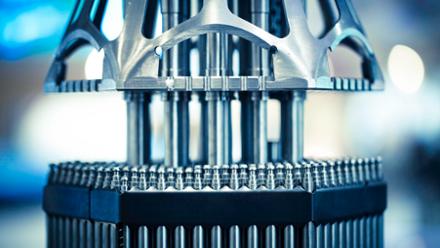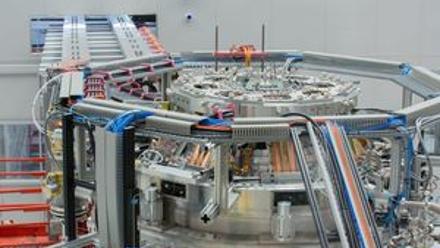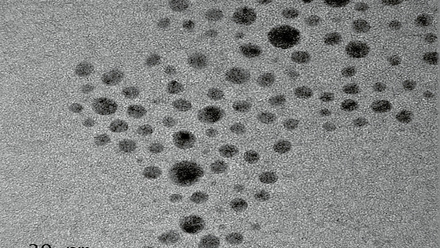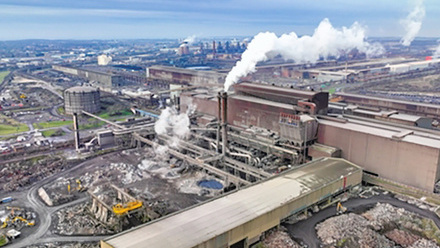Next-generation nuclear reactor
Daniel Cooper, Chief Chemist at Seaborg Technologies discusses the ongoing development of its Compact Molten Salt Reactor and the material challenges that go along with operating in extreme environments.
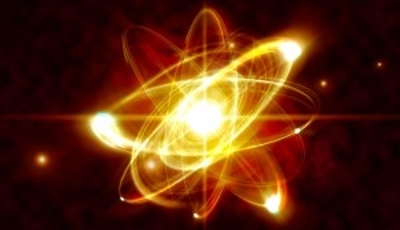
Abundant scientific evidence has shown that we are currently experiencing a climate crisis. If we don’t rapidly cut our greenhouse gas emissions, there will be disastrous consequences. Many countries have been pursuing renewable energy technologies such as photovoltaics and wind turbines. These have seen a tremendous reduction in capital cost, but their intermittency creates an almost impossible task to scale them to the levels of energy we need.
Despite this effort, greenhouse gas emissions are still rising steeply, particularly in countries which are trying to escape energy poverty. However, there are a handful of countries, such as France and Sweden, which already have electricity grids with low greenhouse emissions, and one of the biggest contributors to their clean energy production is nuclear power.
Ready to scale
At Seaborg Technologies, we are developing an advanced, next-generation nuclear reactor called the Compact Molten Salt Reactor (CMSR). It addresses many of the concerns with nuclear energy – it can recycle nuclear waste, it cannot be used to produce nuclear weapons, and the risk of a meltdown or explosion is eliminated through the laws of nature. These innovations ensure that the CMSR will be cheaper than coal, easy to scale-up and highly dispatchable, enabling humanity to solve the climate crisis economically.
A nuclear plant converts the energy released by nuclear fission to electricity via a steam turbine. Nuclear fission is the process of splitting atoms apart, this probability can be increased by hitting the atoms with neutrons. When an atom absorbs a neutron and becomes unstable, it splits apart to become two fragments which are more stable. When the atom splits, a huge amount of energy and several more neutrons are released.
A nuclear reactor is designed to balance the number of neutrons and ensure that one fission leads to exactly one more fission. Conventional reactors use solid fuel – such as uranium dioxide, which is typically cooled by pressurised water. The pressurised water transfers the heat from fission to a steam generator, then steam pushes a turbine to generate electricity in the same way as a coal or biomass plant.
Molten salt reactors (MSRs) differ from conventional reactors in many ways, but the key difference is that the fuel is a liquid. There are several salt compositions which contain uranium and have melting points that are ideal for transferring the heat from nuclear fission to a steam turbine. The benefit of using these molten salts is that their fluid dynamic properties are not too dissimilar to water, yet their boiling points are much higher. To increase the efficiency of converting heat to electricity, water-cooled reactors have thick pressure vessels to pressurise the water and increase the boiling point.
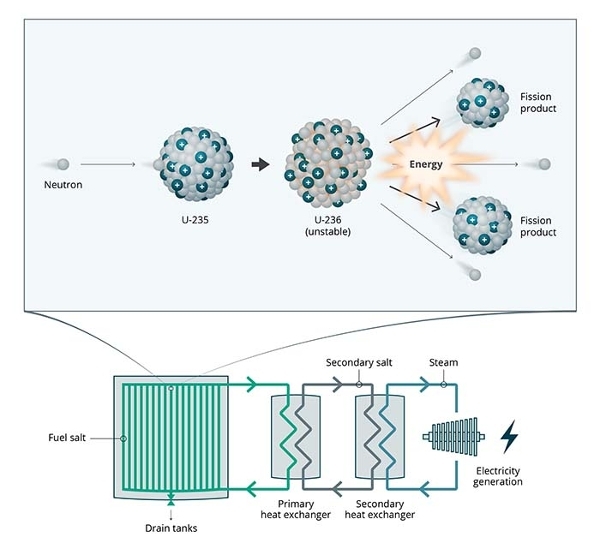
With molten salts, you remove the necessity to pressurise the reactor. This not only removes the key risk of a nuclear reactor – the sudden pressure release that occurred during all major nuclear accidents – it also makes the reactor significantly cheaper to build.
The fact that the fuel is liquid also means that if there are any sudden temperature changes, the fuel can expand, and the lower density decreases the probability that fission will occur and slows down the nuclear reaction. If a significant accident occurs, the fuel can be drained to tanks which are designed to prevent the chain reaction from occurring, stopping the fission process and allowing the reactor to cool naturally. If fluoride salts are used for the fuel, the low solubility of fluorides in water means that even if all the containment barriers are breached, the radioactive material will struggle to be transported through the environment.
A US priority
Molten salt reactors are not a new idea. The concept was first developed in the early days of nuclear power when the US Navy realised the potential of nuclear reactors. A power source that required very little fuel and produced very little waste was ideal to power submarines, enabling the crew to remain submerged for long periods of time. As such, a huge effort was put into developing water-cooled reactors, a very sensible idea when you’re surrounded by a vast ocean of water. The US Air Force wanted to extend the idea to aircraft and develop a nuclear-powered plane which wouldn’t have to be refuelled.
An MSR was the natural choice because you could build a very compact reactor which could achieve the high temperatures required to power jet turbines and forced convection could be used to overcome challenges with changes in gravity. As such, the Aircraft Reactor Experiment (ARE) was conducted, a 2.5MWth MSR that operated in 1954. However, the programme was cancelled when air-to-air refuelling was developed – and later made obsolete by the development of intercontinental ballistic missiles – but it was succeeded by a project to develop a commercial MSR. The Molten Salt Reactor Experiment (MSRE) was developed and built, an 8MWth reactor that operated from 1965 to 1969. This MSR programme was also cancelled. Cited reasons include budget cuts and materials issues.
Exploring moderator options
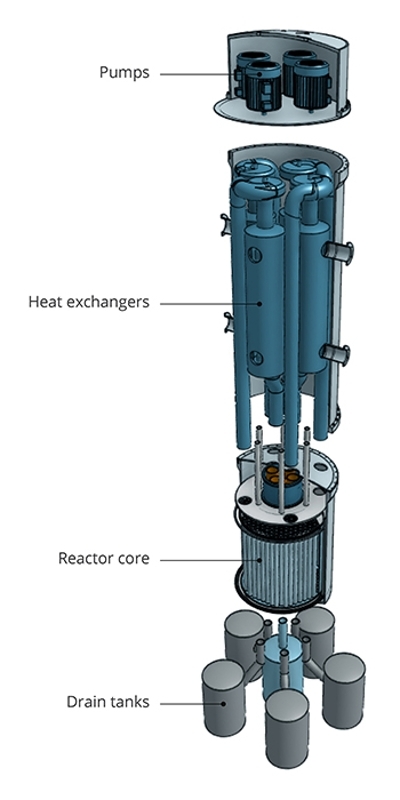
The main materials issue concerned the graphite moderator. Nuclear fission reactors come in two kinds – thermal reactors and fast reactors. When fission occurs, the neutrons that are released travel very fast. This limits the probability that they will hit an atom of fuel and be captured by it. As such, you either need to increase the size of your nuclear reactor or increase the concentration of atoms that can be fissioned through enrichment, for example, increasing the ratio of U-235 to U-238. The high enrichment required for fast reactors can be a significant concern for nuclear weapons proliferation. To increase the probability that neutrons will be captured by the fuel, a compound called a moderator can be introduced.
The moderator interacts with neutrons and steals some of their energy, causing them to slow down and making them more likely to hit an atom of fuel. A nuclear reactor that has a moderator is called a thermal reactor, whereas one that doesn’t have a moderator is called a fast reactor.
The MSRs built at Oak Ridge National Laboratory were both thermal reactors. The moderator in the ARE was beryllium oxide, which is expensive, so graphite was used in the MSRE and its successors which were designed for commercial use.
Graphite was a sensible choice because it can withstand the high operating temperatures and it doesn’t chemically degrade in molten salts. However, when graphite is bombarded with neutrons it suffers a lot of irradiation damage. It has a bit of an odd interaction – first it contracts, then as it accumulates more damage, it swells. This process of contraction and swelling causes cracks to form. The molten salt is in direct contact with the graphite, so it penetrates the cracks. The fuel continues to fission, producing heat which can no longer be removed, and eventually the molten salt in the cracks can get hot enough to boil and enlarge the cracks.
To make MSRs feasible, you have a few options to overcome the issues with graphite. One option is to increase the enrichment, so that you can operate with a lower neutron flux causing less irradiation damage. However, the required highly enriched fuel is a proliferation risk. A second option is to develop new graphite materials, which are much more resistant to irradiation damage. Considering that graphite has a layered, anisotropic structure, it isn’t hard to see that you have a lot of options for developing graphite with unique microstructures that may overcome the issue.
A third method is to completely remove the moderator and develop a fast reactor. The issue here is that your reactor needs to be very large to be economical, making it a poor market fit. There are also a lot of restrictions with fast reactor technologies because they can be very useful for producing weapons-grade materials.
Working with sodium hydroxide
A fourth option is to develop a new moderator. This is the approach that we are taking at Seaborg Technologies. Our moderator is sodium hydroxide, which has melting and boiling points in a similar range to the molten fuel salts and does not degrade under irradiation damage. However, sodium hydroxide introduces another challenge – corrosivity. Sodium hydroxide was considered as a moderator in the early era of nuclear reactor development, but the corrosion issues couldn’t be overcome. Since then, a lot of understanding has been developed with regards to the chemistry of molten hydroxides. A key finding is that molten hydroxides have acid-base properties, somewhat similar to water. The acid-base properties of molten hydroxides are essentially affected by the concentration of water present.
If a large concentration of water is present then the molten hydroxide is acidic, whereas if a very small concentration of water is present then the molten hydroxide is basic. When you heat a molten hydroxide to high temperature, the water evaporates, and you produce a very basic molten hydroxide. Basic molten hydroxides are corrosive to many materials, particularly the iron- and nickel-based alloys which are typically used for construction of high-temperature nuclear reactors. However, nickel-based alloys form a stable passivation layer in acidic molten hydroxides, so if you control the chemistry of the molten hydroxide and ensure to retain a small water concentration, the corrosion rate is significantly reduced.
Extreme conditions
Arguably, our biggest challenge is to develop materials that can withstand the harsh environment inside the CMSR. The reactor core consists of fuel tubes that pass through a pool of molten hydroxide moderator. These therefore have to withstand corrosion by molten fluoride on the inside and corrosion by molten hydroxide on the outside. They also have to possess sufficient mechanical strength at the high operating temperatures and withstand a large amount of irradiation damage. Developing novel materials isn’t ideal because a huge amount of work is required to approve new materials for use in nuclear reactors.
A nickel-based superalloy called Hastelloy N was developed at Oak Ridge specifically for use in MSRs. Issues were encountered with tellurium embrittlement and helium bubble accumulation, but these have largely been overcome through slight changes to the alloy composition. Some further qualification is required before it can be used in high-temperature nuclear reactors, but it is commercially available. Although, its resistance to molten hydroxides is currently unknown. We are also investigating alternative solutions that look very promising.
We undoubtedly have a lot of work ahead of us, but as the old saying goes, ‘If it was easy, then someone would have already done it’. With the climate crisis humanity is facing, we absolutely need to succeed more than ever.


